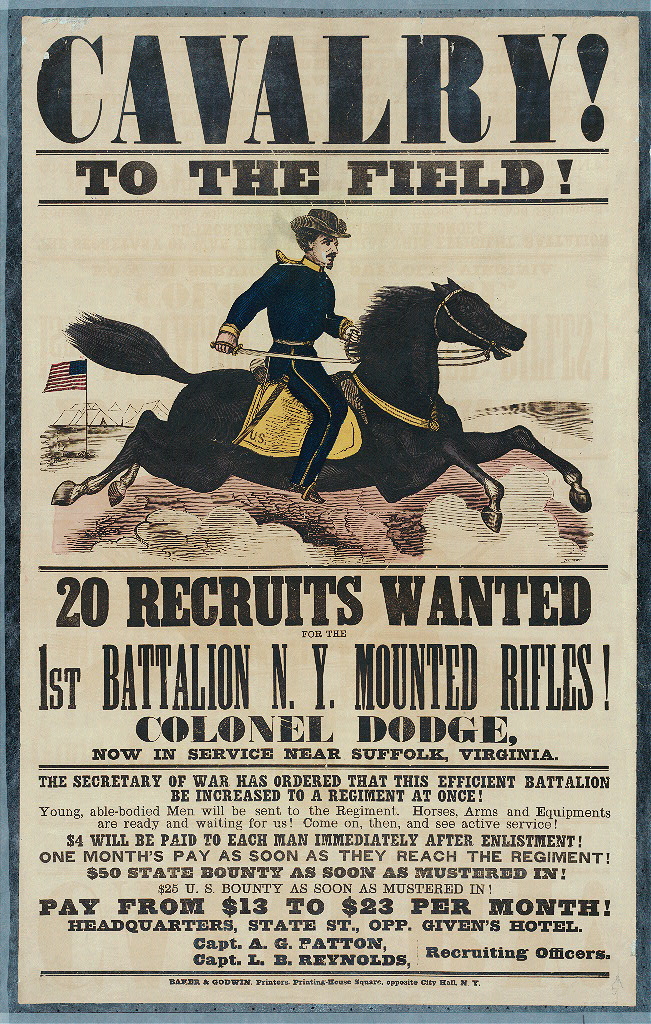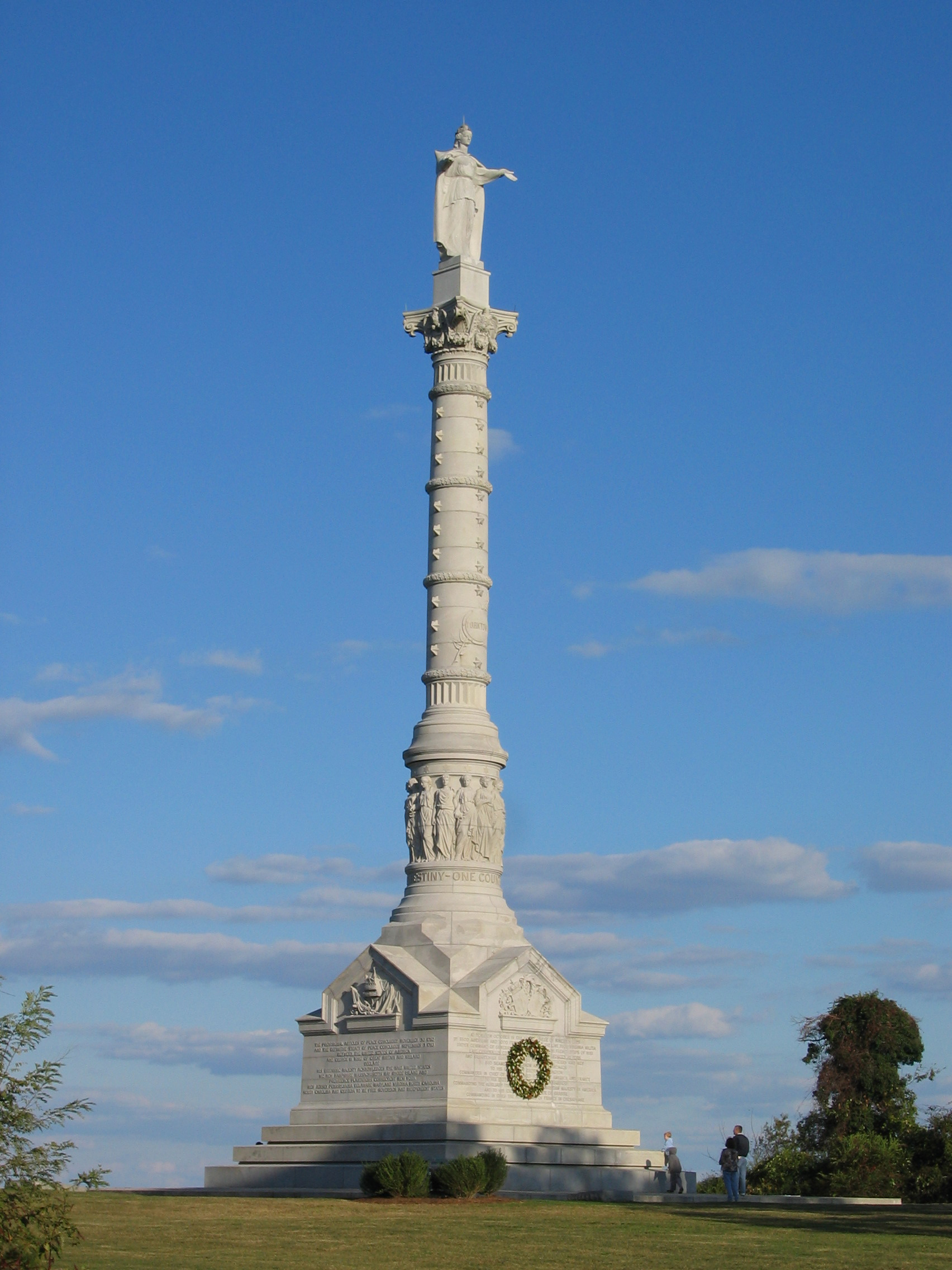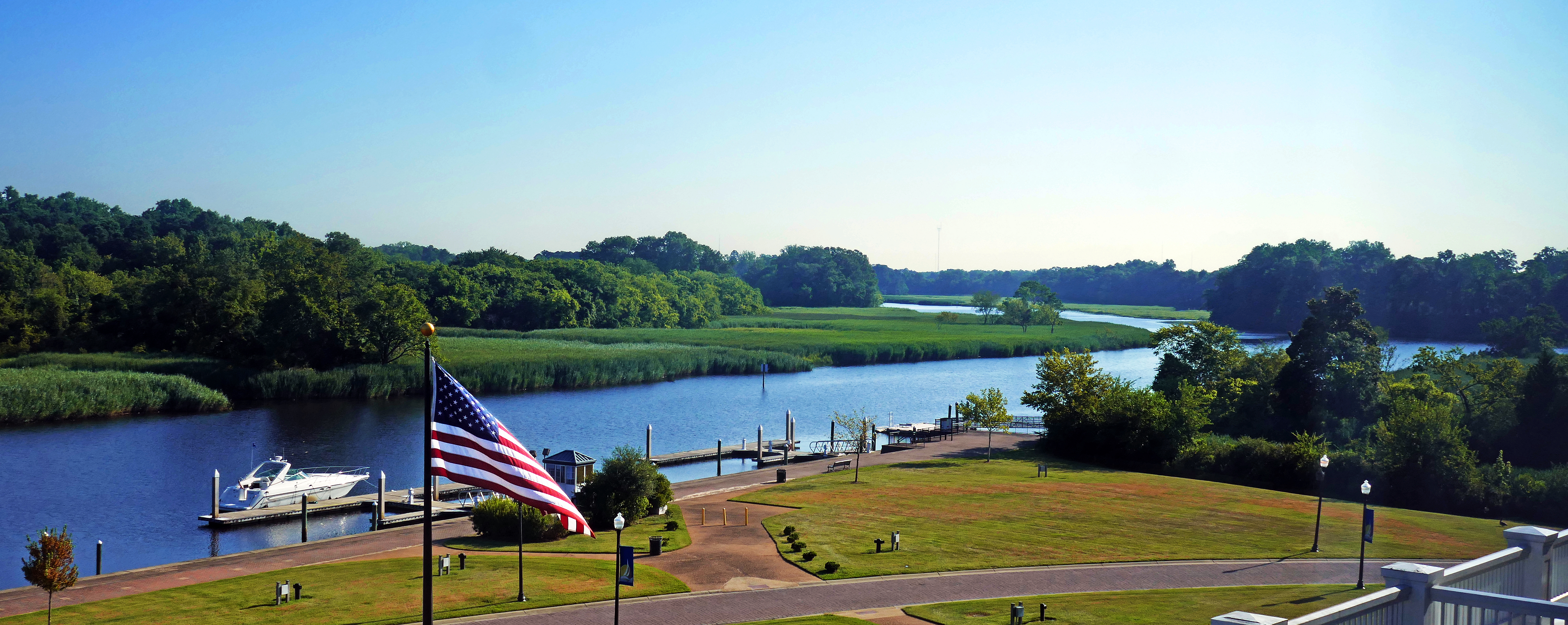|
1st Regiment New York Mounted Rifles
The 1st Regiment New York Mounted Rifles, sometimes designated 7th Regiment New York Volunteer Cavalry, was a cavalry regiment of the Union Army during the American Civil War. Service Companies organized and mustered in between July 1861 and September 1862, and served in the Department of Virginia (VII Corps and IV Corps) and Department of Virginia and North Carolina, principally at Fort Monroe, Norfolk and Suffolk, Portsmouth, Williamsburg and Yorktown, Virginia; in Wistar's Division, XVIII Corps, from January 1864; in the Cavalry, Army of the James, with the 3d Brigade, 1st Division, X Corps, from March 1864; a detachment as escort, headquarters Army of the James, from July 1864; unattached from August 1864; in the 3d Brigade of the Cavalry Division, Army of the James, until March 1865; again unattached to the close of the war; and at Fredericksburg, Virginia, from April 1865. Companies H and D served with the 10th Corps from June 1864; with XVIII Corps from August 1864. Jul ... [...More Info...] [...Related Items...] OR: [Wikipedia] [Google] [Baidu] |
Union (American Civil War)
During the American Civil War, the Union, also known as the North, referred to the United States led by President Abraham Lincoln. It was opposed by the secessionist Confederate States of America (CSA), informally called "the Confederacy" or "the South". The Union is named after its declared goal of preserving the United States as a constitutional union. "Union" is used in the U.S. Constitution to refer to the founding formation of the people, and to the states in union. In the context of the Civil War, it has also often been used as a synonym for "the northern states loyal to the United States government;" in this meaning, the Union consisted of 20 free states and five border states. The Union Army was a new formation comprising mostly state units, together with units from the regular U.S. Army. The border states were essential as a supply base for the Union invasion of the Confederacy, and Lincoln realized he could not win the war without control of them, especially Maryla ... [...More Info...] [...Related Items...] OR: [Wikipedia] [Google] [Baidu] |
Union Army
During the American Civil War, the Union Army, also known as the Federal Army and the Northern Army, referring to the United States Army, was the land force that fought to preserve the Union (American Civil War), Union of the collective U.S. state, states. It proved essential to the preservation of the United States as a working, viable republic. The Union Army was made up of the permanent Regular Army (United States), regular army of the United States, but further fortified, augmented, and strengthened by the many temporary units of dedicated United States Volunteers, volunteers, as well as including those who were drafted in to service as Conscription in the United States, conscripts. To this end, the Union Army fought and ultimately triumphed over the efforts of the Confederate States Army in the American Civil War. Over the course of the war, 2,128,948 men enlisted in the Union Army, including 178,895 United States Colored Troops, colored troops; 25% of the white men who s ... [...More Info...] [...Related Items...] OR: [Wikipedia] [Google] [Baidu] |
Army Of The James
The Army of the James was a Union Army that was composed of units from the Department of Virginia and North Carolina and served along the James River (Virginia), James River during the final operations of the American Civil War in Virginia. History The Union Departments of Virginia and North Carolina merged in 1863. Troops from these departments formed the XVIII Corps (Union Army), XVIII Corps. In April 1864 the X Corps (Union Army), X Corps was transferred from the Department of the South and the two corps formed the Army of the James. Major general (United States), Maj. Gen. Benjamin Butler (politician), Benjamin F. Butler was placed in command. During Lieutenant general (United States), Lt. Gen. Ulysses Grant's Overland Campaign in 1864, Butler made several unsuccessful attempts at Petersburg, Virginia, Petersburg and Richmond, Virginia, Richmond. At the Battle of Cold Harbor the XVIII Corps was sent to act under the Army of the Potomac. The XVIII Corps also participated in the ... [...More Info...] [...Related Items...] OR: [Wikipedia] [Google] [Baidu] |
XVIII Corps (Union Army)
XVIII Corps was a North Carolina corps of the Union Army during the American Civil War. Origins and makeup The XVIII Corps was created on December 24, 1862. It was initially composed of five divisions stationed in North Carolina, making it one of the largest in the Union Army (though two were detached to join the X Corps in early 1863), and placed under the command of General John G. Foster. By August 1863, most of the corps' original units were either disbanded or transferred elsewhere, but Brig. Gen. George W. Getty's division (formerly of IX Corps) and the bulk of the recently discontinued VII Corps from Virginia were redesignated the XVIII Corps. Operations During the spring of 1864, the corps—now commanded by General William Farrar Smith, formerly of VI Corps—was transferred to Yorktown, Virginia, to join Maj. Gen. Benjamin Butler's Army of the James. The corps played a major part in the unsuccessful operations in the Bermuda Hundred, and was als ... [...More Info...] [...Related Items...] OR: [Wikipedia] [Google] [Baidu] |
Yorktown, Virginia
Yorktown is a census-designated place (CDP) in York County, Virginia. It is the county seat of York County, one of the eight original shires formed in colonial Virginia in 1682. Yorktown's population was 195 as of the 2010 census, while York County's population was 66,134 in the 2011 census estimate. The town is most famous as the site of the siege and subsequent surrender of General Charles Cornwallis to General George Washington and the French Fleet during the American Revolutionary War on October 19, 1781. Although the war would last for another year, this British defeat at Yorktown effectively ended the war in North America. Yorktown also figured prominently in the American Civil War (1861–1865), serving as a major port to supply both northern and southern towns, depending upon who held Yorktown at the time. Yorktown is one of three sites of the Historic Triangle, which also includes Jamestown and Williamsburg as important colonial-era settlements. It is the eastern te ... [...More Info...] [...Related Items...] OR: [Wikipedia] [Google] [Baidu] |
Williamsburg, Virginia
Williamsburg is an Independent city (United States), independent city in the Commonwealth (U.S. state), Commonwealth of Virginia. As of the 2020 United States census, 2020 census, it had a population of 15,425. Located on the Virginia Peninsula, Williamsburg is in the northern part of the Hampton Roads metropolitan area. It is bordered by James City County, Virginia, James City County on the west and south and York County, Virginia, York County on the east. English settlers founded Williamsburg in 1632 as Middle Plantation (Virginia), Middle Plantation, a fortified settlement on high ground between the James River, James and York River (Virginia), York rivers. The city functioned as the capital of the Colony of Virginia, Colony and Commonwealth of Virginia from 1699 to 1780 and became the center of political events in Virginia leading to the American Revolution. The College of William & Mary, established in 1693, is the second-oldest institution of higher education in the United ... [...More Info...] [...Related Items...] OR: [Wikipedia] [Google] [Baidu] |
Portsmouth, Virginia
Portsmouth is an independent city in southeast Virginia and across the Elizabeth River from Norfolk. As of the 2020 census, the population was 97,915. It is part of the Hampton Roads metropolitan area. The Norfolk Naval Shipyard and Naval Medical Center Portsmouth are historic and active U.S. Navy facilities located in Portsmouth. History In 1620, the future site of Portsmouth was recognized as a suitable shipbuilding location by John Wood, a shipbuilder, who petitioned King James I of England for a land grant. The surrounding area was soon settled as a plantation community.City of Portsmouth, Virginia - History [...More Info...] [...Related Items...] OR: [Wikipedia] [Google] [Baidu] |
Suffolk, Virginia
Suffolk is an independent city in the Commonwealth of Virginia, and as such has no county. As of the 2020 census, the population was 94,324. It is the 9th most populous city in Virginia and the largest city in Virginia by boundary land area as well as the 14th largest in the country. Suffolk is located in the Hampton Roads metropolitan area. This also includes the independent cities of Chesapeake, Hampton, Newport News, Norfolk, Portsmouth, and Virginia Beach, and smaller cities, counties, and towns of Hampton Roads. With miles of waterfront property on the Nansemond and James rivers, present-day Suffolk was formed in 1974 after consolidating with Nansemond County and the towns of Holland and Whaleyville. The current mayor (as of 2021) is Mike Duman. History Prior to colonization, the region was inhabited by the indigenous Nansemond people. The settlement of Suffolk was established in 1742 by Virginian colonists as a port town on the Nansemond River. It was originally na ... [...More Info...] [...Related Items...] OR: [Wikipedia] [Google] [Baidu] |
Norfolk, Virginia
Norfolk ( ) is an independent city in the Commonwealth of Virginia in the United States. Incorporated in 1705, it had a population of 238,005 at the 2020 census, making it the third-most populous city in Virginia after neighboring Virginia Beach and Chesapeake, and the 94th-largest city in the nation. Norfolk holds a strategic position as the historical, urban, financial, and cultural center of the Hampton Roads region, which has more than 1.8 million inhabitants and is the thirty-third largest Metropolitan Statistical area in the United States. Officially known as ''Virginia Beach-Norfolk-Newport News, VA-NC MSA'', the Hampton Roads region is sometimes called "Tidewater" and "Coastal Virginia"/"COVA," although these are broader terms that also include Virginia's Eastern Shore and entire coastal plain. Named for the eponymous natural harbor at the mouth of the Chesapeake Bay, Hampton Roads has ten cities, including Norfolk; seven counties in Virginia; and two counties in No ... [...More Info...] [...Related Items...] OR: [Wikipedia] [Google] [Baidu] |
Fort Monroe
Fort Monroe, managed by partnership between the Fort Monroe Authority for the Commonwealth of Virginia, the National Park Service as the Fort Monroe National Monument, and the City of Hampton, is a former military installation in Hampton, Virginia, at Old Point Comfort, the southern tip of the Virginia Peninsula, United States. Along with Fort Wool, Fort Monroe originally guarded the navigation channel between the Chesapeake Bay and Hampton Roads—the natural roadstead at the confluence of the Elizabeth, the Nansemond and the James rivers. Union General George B. McClellan landed his forces at the fort during Peninsula campaign of 1862 during the American Civil War. Until disarmament in 1946, the areas protected by the fort were the entire Chesapeake Bay and Potomac River regions, including the water approaches to the cities of Washington, D.C. and Baltimore, Maryland, along with important shipyards and naval bases in the Hampton Roads area. Surrounded by a moat, the six-side ... [...More Info...] [...Related Items...] OR: [Wikipedia] [Google] [Baidu] |
Department Of Virginia And North Carolina
The Department of Virginia and North Carolina was a United States Military department encompassing Union-occupied territory in the Confederate States during the Civil War. In 1863 it was formed by the merging of two previously existing departments: the Department of Virginia and the Department of North Carolina. In 1865 the two departments were once again separated. Department of Virginia 1861 The Department of Virginia was created on May 22, 1861, to include any areas within a 60-mile radius of Fort Monroe and any sections of North Carolina and South Carolina occupied by the Union Army. Major General Benjamin F. Butler was appointed its first commander. Early battles undertaken by troops from this department under General Butler included actions at Big Bethel and Hatteras Inlent. Early on the department was also known as the Department of Southeastern Virginia. On January 7, 1862, the areas of North Carolina were detached to form the Department of North Carolina. On Ju ... [...More Info...] [...Related Items...] OR: [Wikipedia] [Google] [Baidu] |
IV Corps (Union Army)
There were two corps of the Union Army called IV Corps during the American Civil War. They were separate units, one serving with the Army of the Potomac and the Department of Virginia in the Eastern Theater, 1862–1863, the other with the Army of the Cumberland in the Western Theater, 1863–1865. IV Corps (Eastern Theater) The IV Corps, Army of the Potomac, was created on March 13, 1862, and placed under the command of Erasmus D. Keyes, who had commanded a brigade at First Bull Run. It consisted initially of three divisions, under Darius N. Couch, Silas Casey, and William F. "Baldy" Smith. Couch's division was transferred to join VI Corps during the Antietam Campaign and remained with them for the duration of the war. The corps' peak strength (in early 1862) was 37,000 men. The corps took part in George B. McClellan's Peninsula Campaign of 1862, playing a major role in repulsing Confederate attacks at Seven Pines and Malvern Hill. After the campaign, IV Corps remai ... [...More Info...] [...Related Items...] OR: [Wikipedia] [Google] [Baidu] |







